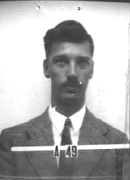James Leslie Tuck was a British physicist and a member of the British Mission to Los Alamos during the Manhattan Project.
Born in Manchester, England in 1910, Tuck studied physics at the Victoria University of Manchester and later appointed Research Fellow at Oxford University, where he worked with Leó Szilárd on particle accelerators. In 1939, Tuck became scientific advisor to Frederick Alexander Lindemann, who was on the private staff of Winston Churchill. Tuck was tasked with researching shaped charges which were eventually used in anti-tank weapons during World War II.
Tuck's experitse on shaped charges made him a natural selection for the British Mission to Los Alamos, where he helped in the development of the explosives lenses and the Urchin initiator used in the plutonium atomic bomb.
After the War, Tuck began work on thermonuclear power at Los Alamos. There he research the possibilities of fusion power and led a team of scientists to develop promising fusion reactors. After his retirement in 1972, Tuck became a prominent public supporter of thermonuclear fusion for power generation.





